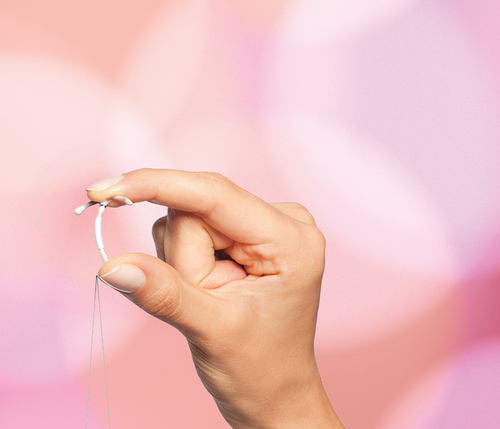
During a week of jam-packed news (are there any other kind these days?), the announcement of Justice Kennedy’s retirement hit home for a lot of people—and stirred up debate about the future of reproductive health in the US. For a few hours, my Twitter feed literally became flooded with women giving each other the low-down on the different kinds of long-acting reversible contraceptives (LARCs) that they use.
But remember, these options may not be for everyone. As Dr. Sherry A. Ross, Women’s Health Expert and Author of She-ology. The Definitive Guide to Women’s Intimate Health. Period. told me, “Women who are not a candidate for LARC’s include women who want a birth control method that will help control acne, premenstrual symptoms, balance hormonal levels, protect against ovarian cancer or ovarian cysts or want a birth control covered by insurance policies. Other reasons you are not a candidate for an IUD include those who have had PID (pelvic inflammatory disease); may be pregnant or have had or at risk of having an ectopic pregnancy; may have breast, cervical or uterine cancer; have uterine fibroids; or may have an allergy to the components in the Skyla, Mirena, Liletta or Paragard IUD.”
Since we always want you to know your options and make informed decisions about what’s best for your body, we think this is as good a time as any to break down the different kinds of implants and IUDs out there that you can purchase to secure your preferred way of life.
Implant/Nexplanon
The Nexplanon is a small plastic implant (like, 1.6 inches) that a doctor inserts into your upper arm—good news, you get a numbing shot beforehand. It releases progestin, a hormone found in most birth control pills, to prevent pregnancy. The Nexplanon was released in 2016 as the updated version of the Implanon thanks to its radiopaque quality, which makes it even easier for doctors to monitor your implant and make sure it’s where it’s supposed to be. The implant is over 99 percent effective in keeping you baby-free and can last up to four years, which is why they like to call it “set-it-and-forget-it” birth control (although it’s not suitable if you’ve had breast cancer). However, when it comes to your period, it completely varies: some women experience shorter or no periods while others experience longer or even spotting in-between periods.
Nexplanon will protect you instantly if you get it implanted during the first five days of your period. Otherwise, keep using another form of birth control for the first week. And remember that it doesn’t guard you against STDs, so you will still want to keep condoms handy to have safe sex. One last thing—since our bodies are all unique and amazing in their own ways, they can react differently to treatments. Make sure you keep an eye on your side effects and let your doctor know if you have any uncommon symptoms after getting your implant. Plus, you can get the Nexplanon removed at any time if you decide that you’re ready for that #momglow, or for a different kind of birth control.
Skyla
Skyla is a hormonal IUD made of plastic that a doctor can insert through your cervix and into your uterus to prevent pregnancy for up to three years. Like with all IUDs, the insertion process is quick but can make some people feel pain, cramps, or dizziness—so set aside some extra #mychilltime for after the procedure. And good news: like all IUDs, it is over 99 percent effective in protecting you from an unexpected pregnancy. “The IUD has been around a long time but for many, it’s the ‘new kid’ on the block since women of all ages are now considered eligible to use it,” says Dr. Ross. “The Skylar, Kyleena or Liletta IUD are now the newest members of the family and great alternatives for women who have never had been pregnant. It is ideal and well tolerated by teenagers.”
Skyla releases the lowest amount of progestin out of any hormonal IUD and is also the smallest in size, which may be ideal for those of us who haven’t had a baby yet. It may cause spotting in the first few months, but can help decrease period cramps and make your period lighter altogether. If you don’t want your period to stop completely, then Skyla could be a good choice for you—only about 6 percent of women that get Skyla stop getting their period in the first year.
Kyleena
From the same maker as Skyla (and Mirena, as you will soon learn), Kyleena is like the middle child of hormonal IUDs. It also releases a low-dose of progestin (levonorgestrel, if you want to be exact), but can last up to five years. Kyleena is over 99 percent effective for women regardless of whether or not you’ve had a baby, and can cause light spotting in the first few months. However, good news if you still want to get your period because only 12 percent of women with Kyleena stopped experiencing menstruation in the first year after insertion. Oh, and if you worry about your IUD moving—your doctor can teach you to do a monthly thread check so you can always make sure its where it’s supposed to be.

Mirena
If you can’t deal with your heavy period any longer, Mirena might be a good fit for you. From the same maker as Skyla and Kyleena, Mirena releases more hormones than its younger sistas and lasts for up to five years. It specifically treats heavy periods, and about 20 percent of women who have Mirena say they stopped getting theirs altogether in the first year after insertion. Mirena is more than 99 percent effective in preventing pregnancy regardless of whether or not you’ve had a baby, and it may cause some spotting in the first few months after insertion.
Liletta
Still in the hormonal branch, Liletta is an IUD that can last for up to four years. It releases slightly fewer hormones than Mirena and is over 99 percent effective in preventing pregnancy. You can expect spotting or light bleeding for the first several months following insertion, and some women’s periods may stop altogether. Oh, and did we mention that Liletta is known for its affordability? It all depends on your resources and insurance plan, but their website offers simple steps for calling your insurance company and checking at what price Liletta is available to you.
ParaGard
Last but certainly not least, I present you the ParaGard: the copper IUD that everyone keeps talking about. You’ve probably heard your friends say that they either love it or hate it, but here’s some information to keep in mind if you’re thinking of taking the leap. This baby is not hormonal; it’s made of plastic and wrapped in copper, which is how it prevents sperm from getting you pregnant. It lasts 10 years (yes, you heard me) and is over 99 percent effective—plus, it can also act as an emergency contraceptive if you get it within five days of unprotected sex. Because the ParaGard doesn’t release hormones, it will not make your period go away, although it may make it heavier and longer (with spotting in between) for the first few months.
Side note: As always, keep using condoms to protect yourself from STDs and let your doctor know if you feel any discomfort or unusual side effects after your insertion. IUDs can be removed at any time if you want to try to get pregnant (or use another contraceptive).
[Editor’s Note: Since we’re not know-it-alls, always make sure to consult with a doctor (like the ones above) before trying anything new. We’re here to guide and provide information that could potentially help, but each person is different so do what’s right for you! ]
–
Feature Image via Veda

